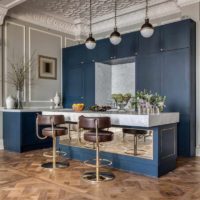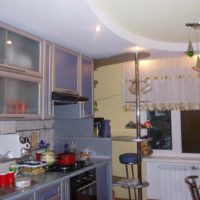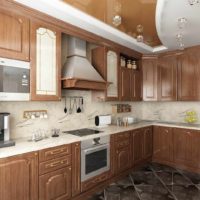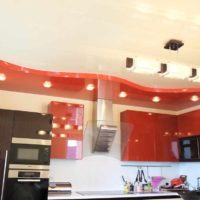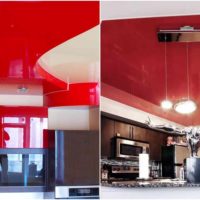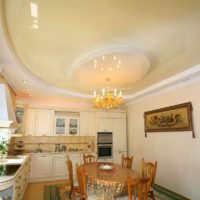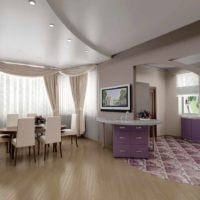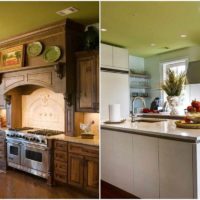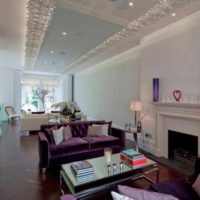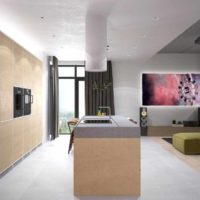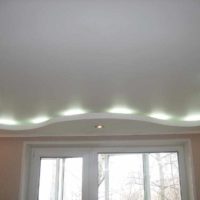Ceiling Design in the Kitchen: Facing Features
Repair in the kitchen is a costly undertaking, it requires a competent selection of finishing materials. The ceiling design in the kitchen is limited by the choice of cladding due to practicality. The cooking process requires frequent cleaning, and fumes and burnt deposits on the walls and ceiling. This requirement is a priority over the aesthetic component of the interior. Often there is no point in making repairs, so we’ll consider all the finishing options to get beautiful, practical and economical.

You need to choose decoration materials for the kitchen very carefully

Ceiling materials should be wiped off quickly.

The interior of the kitchen should ultimately be beautiful and practical.
Content
- 1 What should be the ceiling in the kitchen
- 2 Plasterboard suspended ceilings
- 3 Styrofoam ceiling
- 4 Stretch ceiling
- 5 Decorative plaster on the kitchen ceiling
- 6 Painting and whitewashing
- 7 Plastic ceilings and other modular designs in the kitchen
- 8 Wallpapering
- 9 Ceiling tile
- 10 Recommendations for choosing colors for stylistic decisions
- 11 Video: Kitchen ceiling design
- 12 50 photos of kitchen ceiling design ideas:
What should be the ceiling in the kitchen
The kitchen is a specific room with high humidity, all materials must be moisture resistant. The large-sized room is multifunctional, especially combining the area of the living room to make a spacious dining room.
In addition to preparing and warming up dishes, they eat here, guests are often brought here to conduct confidential conversations. The thoughtful design of this part of the apartment or house is no less important than in the living room. When decorating ceilings in the kitchen, the surface quality is also taken into account - relief defects, stains from roof leaks, seams at the junction of floor slabs.
A competent choice of finishes will help:
- get rid of the imperfections of the ceiling;
- improve the lighting of the kitchen;
- to modernize the room;
- change obsolete coverage;
- decorate the kitchen with practical materials;
- emphasize the choice of interior styling.
When choosing the ceiling design in the kitchen, the general perception and compliance with modern requirements is taken into account. A smooth finish requires leveling. Suspended and suspended structures will take away a few centimeters of ceiling height, but they will effectively hide all the flaws.
The ceiling can be of various shapes:
- smooth;
- figured;
- arched;
- vaulted;
- stepped;
- domed;
- layered.
Each configuration has its own finish. For a smooth ceiling surface, whitewashing and painting, wallpapering remained a classic. Today, the range of finishing materials has expanded. They were supplemented with paneling of various materials, decorative plaster, suspended and suspended ceilings, etc.

It is advisable to choose materials with a water-repellent effect

When choosing materials, consider the features of your kitchen
Important! The combined multi-level ceiling with diode illumination looks good. To prevent fine fat suspension from settling on the walls and ceiling, it is important to install a powerful hood, otherwise the delightful design of the ceiling in the kitchen will quickly lose its initial aesthetics.
The material for the kitchen ceiling must meet the following requirements.
- Aesthetic.
- Practical.
- Moisture resistant.
- Eco-friendly.
- Fire resistant.
- Durable
- Economical.
Each finish has its own "pros" and "cons", there is no one that meets all the requirements. But everyone has their own additional bonuses. For example, it is easy to hide pipes and wiring behind suspended ceilings.You have to choose the sum of the parameters, based on your layout, aesthetic needs and finances. It is worth getting acquainted with all the options for decorating the ceiling in the kitchen.

A multi-level backlit ceiling will look very nice

LED backlighting will create new lines and add novelty to the interior

Ceiling color selection is an important step
Plasterboard suspended ceilings
With this type of finish, you can decorate the ceiling of any configuration without the need for leveling the surface. Due to the lack of costs for plaster and primer, the intricate design of suspended plasterboard ceilings in the kitchen is relatively inexpensive.
The material itself (GKL sheets and the frame for fastening) refers to the budget niche, but the final cost includes installation costs. If you have the skills to work with drywall, it will turn out to be an order of magnitude cheaper. When installing structures, it is possible to hide communication and defects, install diode (or other) lighting, as in the photo.
Disadvantage - installation time is required, including plastering and finishing. The painted surface can be repainted, but it is better not to wash it. Drywall ceiling gives vent to imagination - any curvilinear structures with environmentally friendly materials (cardboard and gypsum) with diode illumination. The material “breathes” - is susceptible to excess moisture.
The design should not be "overloaded" with elements of complex configuration, so that the design of suspended ceilings made of drywall in the kitchen does not seem ridiculous. This is not an end in itself, but a means of designing a vision of a kitchen interior. Amazing lighting design is also available with this ceiling design. In a large dining room, they make general light (pendant lights), point diodes, directional vector devices or LED strip around the perimeter.
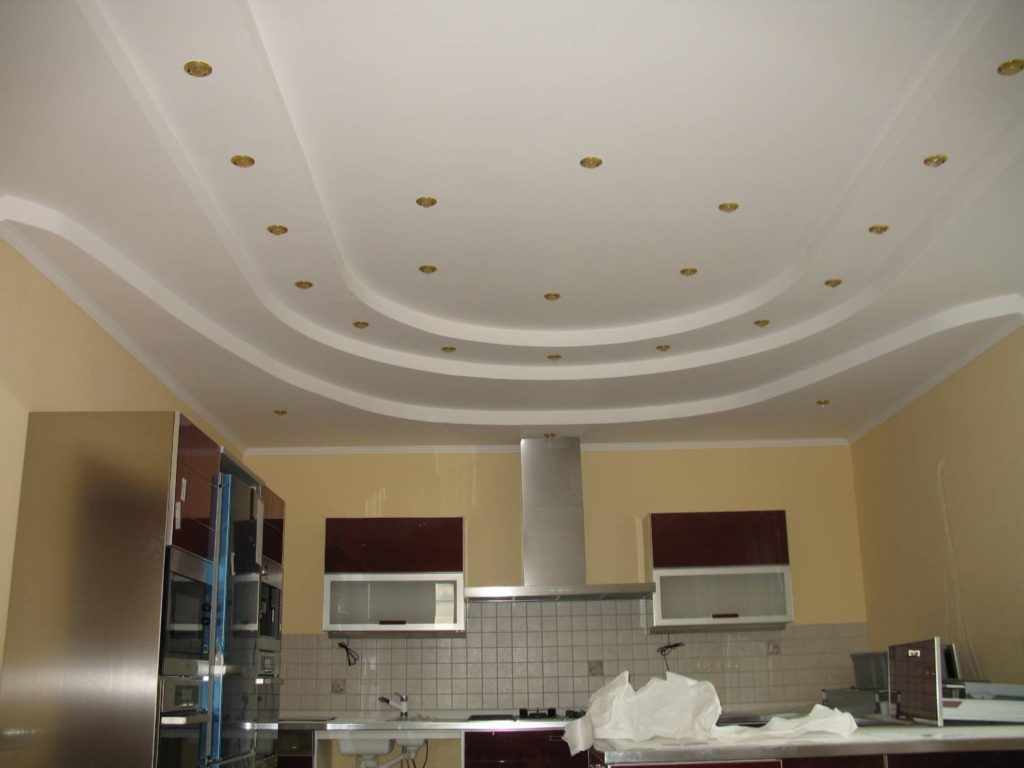
Plasterboard ceilings will fit perfectly into the interior of the kitchen

Using the ceiling, you can hide the internal communications
The design of the ceilings in the kitchen can be made economical or expensive, depending on the overall functionality.
- Flat ceiling.
- Two-level design to hide communications.
- A multi-level solution with sophisticated lighting and a combination of materials, including stretch fabric.
After a while, when you want to upgrade the design, it is enough to change the lining and the lamp, and do not touch the base. The choice of topcoat will emphasize the choice in favor of country style, hi-tech or classics.
Styrofoam ceiling
Many people know the foam, which manufacturers called in a new way. Lightweight and inexpensive material is easy to install, it is easy to cut with scissors and a knife, but special glue for polymers is required, and installation on a primer. You need a flat surface, and small cracks and stains will hide the coating.
This is a simple and convenient material, which is available in the form of plates, moldings and ceiling cornices. All this combines well:
- with whitewash;
- painting;
- smooth drywall.
Among the advantages are resistance to high humidity and ease of installation. A styrofoam tile with a three-dimensional pattern can be repainted with any color over time if treated with a primer. The disadvantage is that the foam burns in case of fire, processing with a special composition is desirable.

Expanded polystyrene plates are easy to install

Such a ceiling is perfect for the kitchen, as it has increased moisture resistance

Such a ceiling can hide internal communications and shortcomings.
Stretch ceiling
The modern variety is successfully used separately from other facing materials, as well as for a plasterboard ceiling - in the design of a large-sized kitchen. You can choose a polymer canvas with any degree of light reflection.
- Frosted.
- Satin
- Glossy.
- With an image.
With a lack of lighting, mirror and glossy ceilings are used - even the black color does not seem dark, as in the photo.
However, the food suspension from cooking settles on the facing materials of the kitchen, the gloss loses its gloss. There are 3 options here - a powerful hood, rare cooking, frequent coating changes.
Stretch ceilings are practical - you can wash with a sponge dipped in a warm soapy solution. Replacing the panel is economical - the frame with harpoon-type baguettes involves repeated use. Specialists will dismantle and tension a new film of any color in 1-2 days.
Attention! If you are flooded by neighbors from above, such a coating will collect water, it will hang, but it will save the interior from unplanned repairs. The profile company will be able to release water and return the film to its previous form.
The modern design of kitchen stretch ceilings requires a combination with diode lamps or chandeliers on the footboard under the canvas. In terms of aesthetics, such a ceiling is excellent, especially in the kitchen combined with the living room. Institutions involved in installation will offer any color and canvas with varying degrees of light reflection. In a narrow kitchen, you get 1 seamless canvas, which is very economical.

Stretch ceilings with LED lighting will look very nice in the interior of the kitchen

If there is little light in the room, you can install a glossy stretch ceiling with a reflective effect
Decorative plaster on the kitchen ceiling
This variety of finishes abounds with raw and decorative options. The use of new technologies and tools is an additional opportunity to create a unique ceiling design in the kitchen. Use colorless varnish to improve the practicality of the coating. It will simplify the washing of the ceiling, fixing the texture, if the plaster crumbles.
Fantasy patterns from roller nozzles and spatulas with a curly edge give new exclusive surfaces. She will hide small ceiling defects. Pigment is added to the textured plaster to get any shade. The finished surface can also be painted or painted, when appropriate, for example, if the stucco wall goes into the decor of the ceiling. Cladding goes well with other textures. For example, in urban styling, decorative plaster and concrete are a hit of the modern kitchen interior.
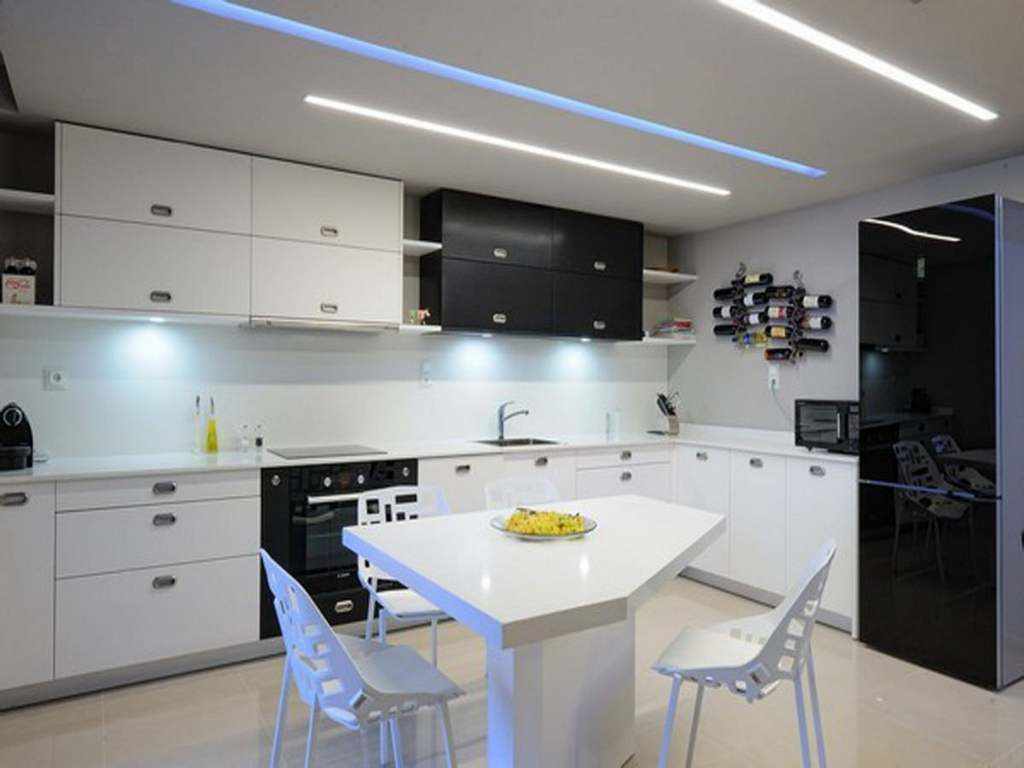
The modern style in the interior of the kitchen will look amazing

Decorative plaster is better varnished for quick cleaning.
Painting and whitewashing
Although whitewashing is an archaic way of processing the ceiling, new technologies do not negate these types of coatings. This is appropriate in private country or Provence houses and in summer houses built in the traditional way (clay instead of plaster). Whitewashing with lime, diluted with chalk - a “friendly” finish coating on the outside and inside, but these components are not always on sale.
Efficiency and practicality of such repairs are beyond doubt. The whitewash is first “washed off” with whitewashing brushes, dipping into water, then whitewash with a lime-chalk solution. Dazzling whiteness is the main advantage of such a surface, which will be an excellent background for the design of any room.
Lime whitewash was replaced by water-based paint, and it was replaced with oil and interior paint based on acrylic. This is the most economical option to repair without assistants. Any painted coating is easy to wash, it is characterized by long-term operation. If desired, you can change the color of the ceiling at the next repainting.
Attention! If whitewashing or painting is applied to the ceilings for the first time, starting plaster and a preliminary primer are needed. You can whiten on a damp surface, paint only on dry!

There are a lot of design options for the ceiling

The ceiling lighting will enliven the interior of the kitchen
Plastic ceilings and other modular designs in the kitchen
Plastic panels - an ideal cladding of a room with high humidity, look quite aesthetically pleasing. The suspended structure on the rack frame will hide all defects.Plastic is often used to “sew up” ceilings on the top floor of a house with a leaking roof. Its practicality and aesthetics are worthy of competition with other materials when you need to choose a common cladding for different rooms:
- kitchens;
- bathroom;
- toilet
- hallway;
- corridors.
Plastic is cheaper than drywall constructions and stretch sheets, PVC panels look flawless. You do not need to hire specialists, except to make a rack frame for the design of the ceiling of the kitchen. Even a woman can insert plastic panels into the crate. It is possible to choose even mirrored or wood-laminated panels. They are easy to wash and dismantle, leaving the old crate when you want changes in the interior.
Today trellised, cassette, rack regiments or other options demanding a preliminary crate gain in popularity. Then you can fix any material on this base, even a mirror or glass tile, if it is a private house. The complexity of installation is offset by the ease of maintenance of practical surfaces. But such a ceiling will “steal” at least 8-10 cm in height. However, it is possible to combine coverings during zoning if it is a studio apartment or an area combined with a loggia and living room.

Choose the color and texture of the ceiling based on the characteristics of the kitchen

The ceiling in the kitchen should be moisture resistant and easy to clean.
Wallpapering
Traditional facing, when, apart from whitewashing, there was no other alternative. Everyone knows about this finishing method, but today special ceiling wallpapers are washable and washable, with a practical film coating that protects the paper from getting wet.
The main advantage is budget repairs and an extensive assortment in terms of textures and colors. It is recommended to use a textured wood pattern, bamboo or cork, when necessary for design in a certain style. This will reduce the cost of repairs, while maintaining visual perception.
It is possible to combine different wallpapers. Looks great along the perimeter of the ceiling frame under the wood and solid blue in the center. This will create the effect of "open sky" to visually expand the room. Ceiling photo prints are also issued, for example, the sky with clouds or branches of blossoming sakura hanging as if hanging into a space without a ceiling.
Thin paper wallpapers are the cheapest, but they break when pasting the ceilings in a spacious room, even when there are assistants. For practicality, choose a solid base with a moisture resistant finish. Wallpaper hides minor defects in the ceiling, but if there are bumps and an uneven joint of floor slabs, then you need plaster. For the ceiling, light shades are chosen.
Ceiling tile
A sufficient economical option, but with materials more convenient for laying technology, it does not seem relevant. Although such a ceiling can compete with other coatings in beauty and practicality, seamless joints and the need for a perfectly flat surface remain a problem. Poor styling will spoil the overall impression of the entire interior due to the sloppy ceiling in the kitchen.
Ceiling tiles should be thin and light so that the weight does not interfere with its fixing. Large-format material is fixed with an aesthetic external crate - this is a duralumin or plastic corner. Tiles made of foam, glass, ceramics, plastic, wood or its imitation are suitable.

The color of the ceiling should match the style of the kitchen.

Ceiling design choose based on personal preferences
Recommendations for choosing colors for stylistic decisions
How to decorate the ceiling in the kitchen with this choice of variations? It all depends on how your room is prepared for cooking.
TABLE
|
1. |
White |
A universal solution for increasing light, it is practiced in all styles of interiors. Choose not a snow-white, but a practical milky shade. |
|
2. |
The black |
An extravagant and mystical color, but with a feeling of “hanging” or lowering the ceiling, is appropriate in modern style. Better glossy stretch fabric, reflecting light, select the backlight. |
|
3. |
Light beige and pastel gamma |
Ideal for any kitchen, it is practical, stylish and aesthetically pleasing. The color of the ceiling is not necessary to duplicate, it is quite self-sufficient. |
|
4. |
Bright color |
Suitable for emotional cheerful design, combined with plain furniture. It is important not to overload the kitchen to the ceiling with color accents - the design needs to be thought out in detail in advance. |
|
5. |
Cold and warm gamut |
Cold shades are suitable for rooms on the south side. A warm range - for kitchens facing north. But the choice of color should be appropriate to the style. |
Do not make sure that the color of the ceiling echoes the elements of decor, but the design and decoration materials should be in harmony with the style of interior design. The rule in the decoration is a light top and a dark bottom, it will help to avoid mistakes. More good examples are in the photo gallery.
Video: Kitchen ceiling design




